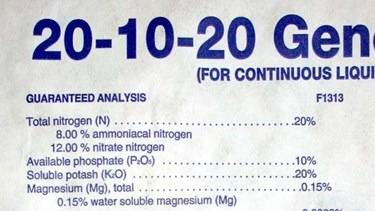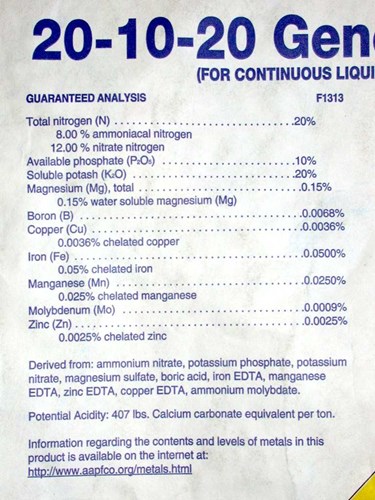How to Read Fertilizer Labels


Fertilizers are necessary to feed plants with nutrients that are not available in the growing medium solution or the irrigation water. They are mined (phosphate rock or potash), synthetic (obtained by a chemical process) or organic products (manures, fish, bones, blood and other organic sources). Fertilizers can be liquid, soluble granules, coated pellets or as simple granules. Plant nutrients come in different concentrations and they can be water soluble, slowly soluble or organic. Synthetic fertilizers are generally available in higher concentrations, compared to organic fertilizers, and are readily available for plant uptake. Organic fertilizers are not readily available for plant uptake but have to be broken down over time by microorganisms. Sometimes enough nutrients are released that the concentration is higher than indicated on the label. All fertilizers dissociate (split) in water into ions which are taken up by plant roots (for example, calcium nitrate Ca(NO3)2 will dissociate into cation Ca2+(aq)+ anion 2NO3-(aq)). Roots do not care about the fertilizer's origin or how they were processed.
Plant nutrients supplied by fertilizers can be divided into three categories: Macronutrients (N, P and K), Secondary nutrients (Ca, Mg and S) and Micronutrients or trace elements (Fe, Mn, Cu, Mo, B, Zn, Ni, Cl, Na, Si, Co and Va). Macronutrients are required by plants in large quantities (several kilograms), secondary nutrients are required in moderate quantities (a few kilograms) and micronutrients are required in small quantities (a few grams). Fertilizers are categorized as complete and incomplete. The first category corresponds to fertilizers that have three macronutrients and the second category has one or two macronutrients. Both categories can have secondary nutrients and micronutrients. Fertilizers containing several nutrients generally cost more than fertilizers containing two nutrients. Moreover, there are special fertilizers for specific purposes, like plugs/liners fertilizers 13-2-13 which contain less nutrient concentration than 20-10-20.

Information on the fertilizer label
- Name of Fertilizer: it can be the analysis of the fertilizer, like 20-10-20, the name of the fertilizer, i.e. calcium nitrate or the functional use of the fertilizer, i.e. dark weather feed.
- Three bold numbers separated by dashes: these numbers are the minimum concentration in percentage of N, P (as phosphate) and K (as potash). The first number is the percentage of total N coming from nitrate, ammonium and/or urea. The second number is the available phosphate (P2O5). Finally, the third number is the soluble potash (K2O). For example: 20-10-20 contains 20% Nitrogen, 10% Phosphate and 20% Potash. Be aware that the actual concentration of each element is obtained by multiplying the percent of the single element by the total weight of the molecule obtained on the bag. Therefore for each 10 Kg or 20-10-20, there is 2 Kg of nitrogen (in the form of ammonium and nitrate), 1 Kg P2O5 (or 0.44 Kg of P) and 2 Kg K2O (or 1.66 Kg K).
- Water type recommendation (water soluble fertilizer): the label can show which level of water alkalinity (low, moderate, medium and/or high) is more suitable for the fertilizer.
- Longevity (controlled released fertilizer): This number is represented by some companies as “type” (13-13-13, Type 140), range of months (13-13-13, 5-6 months) or other designations (13-13-13, 5-6M). These numbers refer to the days or months that the prills will release 80% of the N portion of the fertilizer at an average temperature of 21˚C (70˚F). Using the above examples, the release time is 140 days, 5-6 months and 5-6 months, respectively.
- Guaranteed Analysis: the minimum percentage of each nutrient. It starts with the macronutrients followed by the secondary nutrients and finally the micronutrients. In addition, it shows the source of each nutrient/element.
- Potential acidity or basicity: acidic fertilizers tend to decrease the pH of the growing media over time; these fertilizers have a ratio nitrate: ammonium of 1:0.5 or higher in ammoniacal N. Basic fertilizers have the particularity of increasing the pH of the medium; they have a high ratio of nitrate compared to ammonium. For example, 20-10-20 has a potential acidity of 420 lb calcium carbonate per ton (pounds of calcium carbonate needed to neutralize one ton of fertilizer). On the other hand, calcium nitrate has a potential basicity of 400 lbs of calcium carbonate (one ton of fertilizer acts as 400 lbs of calcium carbonate to bring the pH to neutral).
- Solubility at 20˚C: Each fertilizer has different solubility which is influenced by the type/formulation of fertilizer and the water temperature (the higher the temperature, the higher the solubility). For example, 20-10-20 has a maximum solubility of 360 g/l (3 lbs/gal); whereas, calcium nitrate has a maximum solubility of 1200 g/l (10 lbs/gal).
- Application rates: water soluble fertilizers have tables relating total N application rate, injection ratio of the injector and electrical conductivity (EC) for a certain amount of fertilizer. This table is useful since it can be used to verify the total N of the nutrient solution or the actual injection rate; those values are related to the EC of the nutrient solution. For controlled-release fertilizers or slowly soluble fertilizers, the rate is given as grams per cubic yard of media or as kilograms per square meter.
- Weight or Volume: usually solids fertilizers come in 11 kg (25 lb) bags. Usually, liquid fertilizers come in 9.5-litre containers.
- General Storage and Safety info: fertilizers have to be stored in a cool and dry place; they have to be away from acids and possible contamination with water or food. In the case of an accident, it is necessary to follow the instructions contained on the label.
- Other information: moisture content, bulk density, impurities, viscosity, EC for 1000 ppm, pH of liquid or pH at 10% solution, screen analysis, oxidizer class, CAS number and manufacturer information.
The take-home messages are: fertilizer labels give more information than three bold numbers (N-P-K percentage); the pH of the growing media will depend on the nitrogen source and the application rate will depend on the crop requirements, fertilizer type (liquid, CRF or top dress), container, injector rate and longevity.